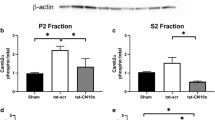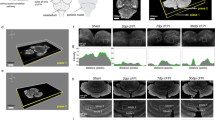Abstract
Background
In studies on cardiac arrest (CA)/resuscitation (R) injury, Purkinje cell degeneration was described, however, with inconsistent data concerning severity and time point of manifestation. Moreover, CA/R studies paid only limited attention to inhibitory stellate interneurons. To this aim, the hypothesis that cerebellar could be relatively resilient toward CA/R because of diverse cellular defense mechanisms including interaction with stellate cells was tested.
Methods
We examined rats with survival times of 6, 24, and 48 h, and 7 and 21 days in comparison with sham- and nonoperated animals. Thereby, we focused on the immunohistochemical expression of cfos, MnSOD, Bcl2, caspase 3, parvalbumin, calbindin D28 k, MAP2, IBA1, and GFAP, especially in the particular sensitivity to CA/R cerebellar lobule IX. Hippocampal CA1 degeneration was demonstrated by expression patterns of MAP2 and NeuN in combination with IBA1 and GFAP.
Results/Conclusions
Comparative analysis of hippocampal CA1 pyramidal cells and cerebellar Purkinje cells confirmed a relative resil-ience of Purkinje cells to CA/R. We found only a notable degeneration of Purkinje cell neuronal fiber network, which, however, not necessarily led to neuronal cell death. To induce significant Purkinje cell loss, a stronger ischemic trigger seems to be needed. As possible Purkinje cell-protecting mechanisms, we would propose: (1) activation of inhibitory stellate cells, shown by cfos, MnSOD, and Bcl2 expression, balancing out ischemia-induced excitation and inhibition of Purkinje cells; (2) translocation of the calcium-buffering system, shown by parvalbumin and calbindin D28 k expression, protecting Purkinje cells from detrimental calcium overload; (3) activation of the neuron–astrocyte cross talk, protecting Purkinje cells from over-excitation by removing potassium and neurotransmitters from the extracellular space; (4) activation of the effective and long-lasting MnSOD defense system; and (5) of the anti-apoptotic protein Bcl2 in Purkinje cells itself. Moreover, the results emphasize the limited comparability of animal CA/R studies because of the heterogeneity of the used experimental regimes.







Similar content being viewed by others
Abbreviations
- Bcl2:
-
B cell lymphoma 2
- CA/R:
-
Cardiac arrest/resuscitation
- DAPI:
-
6-Diamidino-2-phenylindole
- GCL:
-
Granule cell layer
- GFAP:
-
Glial fibrillary acidic protein
- HNF4A:
-
Hepatic nuclear receptor 4A
- IBA1:
-
Ionized calcium-binding adaptor molecule 1
- ID:
-
Integrated density
- IPPV:
-
Intermittent positive pressure ventilation
- LD:
-
Linear density
- MAP2:
-
Microtubule-associated protein 2
- ML:
-
Molecular layer
- MnSOD:
-
Manganese-dependent superoxide dismutase (mitochondrial SOD 2)
- NeuN:
-
Neuronal nuclei antibody
- PBS:
-
Phosphate-buffered saline
- PC:
-
Purkinje cell
- PCL:
-
Purkinje cell layer
- PFA:
-
Phosphate-buffered paraformaldehyde
- ROSC:
-
Return of spontaneous circulation
- ST:
-
Survival time
References
Venkatesan A, Frucht S. Movement disorders after resuscitation from cardiac arrest. Neurol Clin. 2006;24(1):123–32.
Hausmann R, Seidl S, Betz P. Hypoxic changes in Purkinje cells of the human cerebellum. Int J Legal Med. 2007;121(3):175–83.
Paine MG, Che D, Li L, Neumar RW. Cerebellar Purkinje cell neurodegeneration after cardiac arrest: effect of therapeutic hypothermia. Resuscitation. 2012;83(12):1511–6.
Welsh JP, Yuen G, Placantonakis DG, et al. Why do Purkinje cells die so easily after global brain ischemia? Aldolase C, EAAT4, and the cerebellar contribution to posthypoxic myoclonus. Adv Neurol. 2002;89:331–59.
Au AK, Chen Y, Du L, et al. Ischemia-induced autophagy contributes to neurodegeneration in cerebellar Purkinje cells in the developing rat brain and in primary cortical neurons in vitro. Biochim Biophys Acta. 2015;1852(9):1902–11.
Drabek T, Wilson CD, Janata A, et al. Unique brain region-dependent cytokine signatures after prolonged hypothermic cardiac arrest in rats. Ther Hypothermia Temp Manag. 2015;5(1):26–39.
Kantor O, Schmitz C, Feiser J, et al. Moderate loss of cerebellar Purkinje cells after chronic bilateral common carotid artery occlusion in rats. Acta Neuropathol. 2007;113(5):549–58.
Pulsinelli WA, Levy DE, Duffy TE. Regional cerebral blood flow and glucose metabolism following transient forebrain ischemia. Ann Neurol. 1982;11(5):499–502.
Ebmeyer U, Keilhoff G, Wolf G, Rose W. Strain specific differences in a cardio-pulmonary resuscitation rat model. Resuscitation. 2002;53(2):189–200.
Quillinan N, Grewal H, Deng G, et al. Region-specific role for GluN2B-containing NMDA receptors in injury to Purkinje cells and CA1 neurons following global cerebral ischemia. Neuroscience. 2015;284:555–65.
Acosta SA, Mashkouri S, Nwokoye D, Lee JY, Borlongan CV. Chronic inflammation and apoptosis propagate in ischemic cerebellum and heart of non-human primates. Oncotarget. 2017;8(61):102820–34.
Granger DN, Kvietys PR. Reperfusion injury and reactive oxygen species: the evolution of a concept. Redox Biol. 2015;6:524–51.
Kaur C, Sivakumar V, Zou Z, Ling EA. Microglia-derived proinflammatory cytokines tumor necrosis factor-alpha and interleukin-1beta induce Purkinje neuronal apoptosis via their receptors in hypoxic neonatal rat brain. Brain Struct Funct. 2014;219(1):151–70.
Liao SL, Chen WY, Raung SL, Kuo JS, Chen CJ. Association of immune responses and ischemic brain infarction in rat. NeuroReport. 2001;12(9):1943–7.
Orzylowska O, Oderfeld-Nowak B, Zaremba M, Januszewski S, Mossakowski M. Prolonged and concomitant induction of astroglial immunoreactivity of interleukin-1beta and interleukin-6 in the rat hippocampus after transient global ischemia. Neurosci Lett. 1999;263(1):72–6.
Rodrigo J, Alonso D, Fernandez AP, et al. Neuronal and inducible nitric oxide synthase expression and protein nitration in rat cerebellum after oxygen and glucose deprivation. Brain Res. 2001;909(1–2):20–45.
Quillinan N, Deng G, Shimizu K, et al. Long-term depression in Purkinje neurons is persistently impaired following cardiac arrest and cardiopulmonary resuscitation in mice. J Cereb Blood Flow Metab. 2017;37(8):3053–64.
Keilhoff G, Esser T, Titze M, Ebmeyer U, Schild L. Gynostemma pentaphyllum is neuroprotective in a rat model of cardiopulmonary resuscitation. Exp Ther Med. 2017;14(6):6034–46.
Keilhoff G, Esser T, Titze M, Ebmeyer U, Schild L. High-potential defense mechanisms of neocortex in a rat model of transient asphyxia induced cardiac arrest. Brain Res. 2017;1674:42–54.
Katz L, Ebmeyer U, Safar P, Radovsky A, Neumar R. Outcome model of asphyxial cardiac arrest in rats. J Cereb Blood Flow Metab. 1995;15(6):1032–9.
Louis ED, Babij R, Lee M, Cortes E, Vonsattel JP. Quantification of cerebellar hemispheric purkinje cell linear density: 32 ET cases versus 16 controls. Mov Disord. 2013;28(13):1854–9.
Neukomm LJ, Freeman MR. Diverse cellular and molecular modes of axon degeneration. Trends Cell Biol. 2014;24(9):515–23.
Wang AR, Hu MZ, Zhang ZL, et al. Fastigial nucleus electrostimulation promotes axonal regeneration after experimental stroke via cAMP/PKA pathway. Neurosci Lett. 2019;699:177–83.
Sotelo C. Molecular layer interneurons of the cerebellum: developmental and morphological aspects. Cerebellum. 2015;14(5):534–56.
Zhang F, Li C, Wang R, et al. Activation of GABA receptors attenuates neuronal apoptosis through inhibiting the tyrosine phosphorylation of NR2A by Src after cerebral ischemia and reperfusion. Neuroscience. 2007;150(4):938–49.
Heizmann CW, Braun K. Calcium regulation by calcium-binding proteins in neurodegenerative disorders. Neuroscience intelligence unit 1995. New York: Springer; 2013.
Schwaller B. Cytosolic Ca2 + buffers. Cold Spring Harb Perspect Biol. 2010;2(11):a004051.
Tortosa A, Ferrer I. Parvalbumin immunoreactivity in the hippocampus of the gerbil after transient forebrain ischaemia: a qualitative and quantitative sequential study. Neuroscience. 1993;55(1):33–43.
Burke RE, Baimbridge KG. Relative loss of the striatal striosome compartment, defined by calbindin-D28 k immunostaining, following developmental hypoxic-ischemic injury. Neuroscience. 1993;56(2):305–15.
Chen G, Racay P, Bichet S, et al. Deficiency in parvalbumin, but not in calbindin D-28 k upregulates mitochondrial volume and decreases smooth endoplasmic reticulum surface selectively in a peripheral, subplasmalemmal region in the soma of Purkinje cells. Neuroscience. 2006;142(1):97–105.
Timmermans JA, Van Bindels RJ, Os CH. Stimulation of plasma membrane Ca2 + pump by calbindin-D28 k and calmodulin is additive in EGTA-free solutions. J Nutr. 1995;125(7 Suppl):1981S–6S.
Bastianelli E. Distribution of calcium-binding proteins in the cerebellum. Cerebellum. 2003;2(4):242–62.
Bojarski C, Meloni BP, Moore SR, Majda BT, Knuckey NW. Na +/Ca2 + exchanger subtype (NCX1, NCX2, NCX3) protein expression in the rat hippocampus following 3 min and 8 min durations of global cerebral ischemia. Brain Res. 2008;1189:198–202.
von Bernhardi R, Eugenin-von Bernhardi J, Flores B, Leon JE. Glial cells and integrity of the nervous system. Adv Exp Med Biol. 2016;949:1–24.
Barreto GE, Gonzalez J, Torres Y, Morales L. Astrocytic-neuronal crosstalk: implications for neuroprotection from brain injury. Neurosci Res. 2011;71(2):107–13.
Helleringer R, Chever O, Daniel H, Galante M. Oxygen and glucose deprivation induces bergmann glia membrane depolarization and Ca(2 +) rises mainly mediated by K(+) and ATP increases in the extracellular space. Front Cell Neurosci. 2017;11:349.
Cabungcal JH, Steullet P, Morishita H, et al. Perineuronal nets protect fast-spiking interneurons against oxidative stress. Proc Natl Acad Sci USA. 2013;110(22):9130–5.
Walson KH, Tang M, Glumac A, et al. Normoxic versus hyperoxic resuscitation in pediatric asphyxial cardiac arrest: effects on oxidative stress. Crit Care Med. 2011;39(2):335–43.
Kuwamura M, Yoshida T, Yamate J, Kotani T, Sakuma S. Hereditary cerebellar vermis defect in the Lewis rat. Brain Res Dev Brain Res. 1994;83(2):294–8.
Aravamuthan BR, Shoykhet M. Long-term increase in coherence between the basal ganglia and motor cortex after asphyxial cardiac arrest and resuscitation in developing rats. Pediatr Res. 2015;78(4):371–9.
Manto M, Bower JM, Conforto AB, et al. Consensus paper: roles of the cerebellum in motor control–the diversity of ideas on cerebellar involvement in movement. Cerebellum. 2012;11(2):457–87.
Putzu A, Valtorta S, Di Grigoli G, et al. Regional differences in cerebral glucose metabolism after cardiac arrest and resuscitation in rats using [(18)F]FDG positron emission tomography and autoradiography. Neurocrit Care. 2018;28(3):370–8.
Xu H, Lu A, Sharp FR. Regional genome transcriptional response of adult mouse brain to hypoxia. BMC Genom. 2011;12:499.
Acknowledgements
The authors wish to thank Leona Bück for the excellent technical assistance.
Funding
None.
Author information
Authors and Affiliations
Contributions
All authors have made substantive contributions to the study. GK conceived the study, was responsible for data analyses, writing the manuscript and preparing the illustration of results. TMNT carried out all immunohistochemical stainings. TE carried out surgery including post resuscitation care and tissue sampling. UE established the experimental model and supervised the animal experiments and critically reviewed the manuscript.
Corresponding author
Ethics declarations
Conflict of interest
The authors declare no conflict of interest.
Ethical Approval
This study was granted according to the requirements of the German Animal Welfare Act on the Use of Experimental Animals and the Animal Care and Use Committees of Saxony-Anhalt (permit number 42502-2-2-947 Uni MD).
Additional information
Publisher's Note
Springer Nature remains neutral with regard to jurisdictional claims in published maps and institutional affiliations.
Rights and permissions
About this article
Cite this article
Keilhoff, G., Nguyen Thi, T.M., Esser, T. et al. Relative Resilience of Cerebellar Purkinje Cells in a Cardiac Arrest/Resuscitation Rat Model. Neurocrit Care 32, 775–789 (2020). https://doi.org/10.1007/s12028-019-00799-0
Published:
Issue Date:
DOI: https://doi.org/10.1007/s12028-019-00799-0




